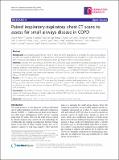| dc.contributor.author | Hersh, Craig Palmer | |
| dc.contributor.author | Washko, George Richard | |
| dc.contributor.author | Estépar, Raúl San José | |
| dc.contributor.author | Lutz, Sharon | |
| dc.contributor.author | Friedman, Paul J | |
| dc.contributor.author | Han, MeiLan K | |
| dc.contributor.author | Hokanson, John E | |
| dc.contributor.author | Judy, Philip Frank | |
| dc.contributor.author | Lynch, David A | |
| dc.contributor.author | Make, Barry J | |
| dc.contributor.author | Marchetti, Nathaniel | |
| dc.contributor.author | Newell, John D | |
| dc.contributor.author | Sciurba, Frank C | |
| dc.contributor.author | Crapo, James D | |
| dc.contributor.author | Silverman, Edwin Kepner | |
| dc.date.accessioned | 2013-10-31T15:14:55Z | |
| dc.date.issued | 2013 | |
| dc.identifier.citation | Hersh, Craig P, George R Washko, Raúl San José Estépar, Sharon Lutz, Paul J Friedman, MeiLan K Han, John E Hokanson, et al. 2013. Paired inspiratory-expiratory chest ct scans to assess for small airways disease in copd. Respiratory Research 14(1): 42. | en_US |
| dc.identifier.issn | 1465-9921 | en_US |
| dc.identifier.uri | http://nrs.harvard.edu/urn-3:HUL.InstRepos:11238936 | |
| dc.description.abstract | Background: Gas trapping quantified on chest CT scans has been proposed as a surrogate for small airway disease in COPD. We sought to determine if measurements using paired inspiratory and expiratory CT scans may be better able to separate gas trapping due to emphysema from gas trapping due to small airway disease. Methods: Smokers with and without COPD from the COPDGene Study underwent inspiratory and expiratory chest CT scans. Emphysema was quantified by the percent of lung with attenuation < −950HU on inspiratory CT. Four gas trapping measures were defined: (1) Exp−856, the percent of lung < −856HU on expiratory imaging; (2) E/I MLA, the ratio of expiratory to inspiratory mean lung attenuation; (3) RVC856-950, the difference between expiratory and inspiratory lung volumes with attenuation between −856 and −950 HU; and (4) Residuals from the regression of Exp−856 on percent emphysema. Results: In 8517 subjects with complete data, Exp−856 was highly correlated with emphysema. The measures based on paired inspiratory and expiratory CT scans were less strongly correlated with emphysema. Exp−856, E/I MLA and RVC856-950 were predictive of spirometry, exercise capacity and quality of life in all subjects and in subjects without emphysema. In subjects with severe emphysema, E/I MLA and RVC856-950 showed the highest correlations with clinical variables. Conclusions: Quantitative measures based on paired inspiratory and expiratory chest CT scans can be used as markers of small airway disease in smokers with and without COPD, but this will require that future studies acquire both inspiratory and expiratory CT scans. | en_US |
| dc.language.iso | en_US | en_US |
| dc.publisher | BioMed Central | en_US |
| dc.relation.isversionof | doi:10.1186/1465-9921-14-42 | en_US |
| dc.relation.hasversion | http://www.ncbi.nlm.nih.gov/pmc/articles/PMC3627637/pdf/ | en_US |
| dash.license | LAA | |
| dc.subject | Emphysema | en_US |
| dc.subject | Chest CT scan | en_US |
| dc.subject | Small airways | en_US |
| dc.subject | Lung function tests | en_US |
| dc.subject | Smoking | en_US |
| dc.title | Paired inspiratory-expiratory chest CT scans to assess for small airways disease in COPD | en_US |
| dc.type | Journal Article | en_US |
| dc.description.version | Version of Record | en_US |
| dc.relation.journal | Respiratory Research | en_US |
| dash.depositing.author | Hersh, Craig Palmer | |
| dc.date.available | 2013-10-31T15:14:55Z | |
| dc.identifier.doi | 10.1186/1465-9921-14-42 | * |
| dash.authorsordered | false | |
| dash.contributor.affiliated | Judy, Philip Frank | |
| dash.contributor.affiliated | Hersh, Craig | |
| dash.contributor.affiliated | Washko, George | |
| dash.contributor.affiliated | Silverman, Edwin | |


